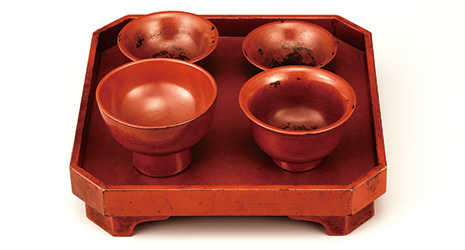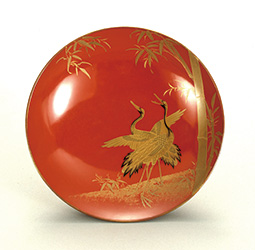INDEX
- English
- 日本語

Yasumazen bowls and table coated with red lacquer - English
- 日本語

Soup bowls inlaid with lobster designs using the chinkin technique

Sake cup with crane and young pine tree created using the makie technique 
Yellow lacquered tiered box with a cherry blossoms and birds design created using the chinkin technique
January 2021
Durable and Elegant Lacquer Ware

Among Japanese traditional crafts, there is a type of lacquerware finishing or coating (nuri) that is known outside of Japan as “Japan” ware. There are a variety of lacquer ware-producing areas all over Japan, and the Wajima-nuri variety is loved by Japanese people as a durable and elegant variety among them.

Wajima-nuri, a type of wooden lacquer ware that is both ornate and durable, is produced in Wajima City, Ishikawa Prefecture, which faces the Sea of Japan. Thought to have originated in the fifteenth century, Wajima-nuri expanded via shipping routes across Japan from the seventeenth century when Wajima flourished as an important point along shipping routes for cargo ships.
According to Wajima Museum of Urushi Art Curator Terao Aiko, “Among wealthy merchants and farmers throughout the nation, demand increased for high-grade lacquer ware to adorn elegant auspicious occasions. Such goods were made using materials including lacquer (sap extracted from the trunks of Japanese lacquer trees), zelkova and other wood used as a base for applying lacquer, diatomaceous earth, and more, all of which was produced in Wajima at the time. From the eighteenth century, the division of labor progressed and a system to mass produce higher quality lacquer ware was established.”

Today, Wajima is a production area representing Japan, boasting a high production value for wooden lacquer ware made with traditional techniques.
There are three stages in the production of Wajima-nuri: creating the wooden base, applying the lacquer, and decorating. Each of these stages is completed using highly specialized manual techniques, and there are more than a hundred steps to the entire process. There are different artisans for each process, and it can take more than a year to complete a single bowl. Moreover, the chinkin technique from the middle of the Edo period (1603–1867) and the makie technique from the Meiji period (1868–1912) were incorporated in earnest, and the popularity of Wajima-nuri grew as the dishes were gorgeously decorated with gold or silver in addition to their durability as practical products. The chinkin technique makes use of the thick coating on Wajima-nuri, where patterns are carved with chisels into the hard lacquer-coated surface and gold leaf or powder is fixed to these carved areas. In the makie technique, patterns are drawn on the surface of the dish using lacquer, and before this hardens, gold, silver or other metal powder is sprinkled on and set into the surface of the dish.

The Wajima Museum of Urushi Art is the only museum in Japan which specializes in lacquer art, exhibiting lacquer work not only from Wajima but also from different regions of Japan as well as overseas.
Curator Terao says, “We also hold workshops where visitors can paint objects such as chopsticks and spoons for themselves. We have prepared written explanations in English and Chinese for overseas visitors.”
After admiring masterpiece works of lacquer ware in the museum, it would surely be fun to create your own original pieces and take them home as presents for family or as souvenirs.

